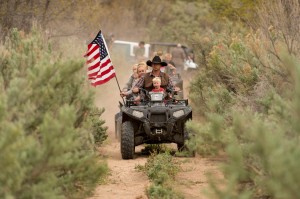In recent months, land rights have been a sore issue among many western states, including Utah. The debate made national news when a Nevada rancher refused to remove his cattle from public land.

Cliven Bundy owns a 160-acre ranch in Bunkerville, Nevada. On March 27 the Bureau of Land Management closed more than 322,000 acres of public land and began to gather up Bundy’s cattle for illegally grazing on public land. This led to a standoff between federal agents and pro-Bundy militia groups demanding the return of the cattle. Citing safety concerns, the BLM returned Bundy’s cattle and reopened the public lands. National attention to this story led to new questions being asked about who should own and manage public lands.
In 1989 the U.S. Fish and Wildlife Service listed the desert tortoise as an endangered species. This new regulation imposed new grazing fees in certain areas, including Bundy’s grazing area, to protect the tortoise. Around this time, Bundy refused to pay his fees (which today total to more than $1 million) and to recognize the authority of the federal government in the region.
Bundy isn’t the only one who has had issues with federal land management agencies. Just recently the municipality of Tombstone, Arizona, found itself with a broken water system after a forest fire created a wash-off that damaged water pipelines. The Forest Service is blocking access to repair the damaged pipelines that provide water for the small town.
In a press release Nick Dranais, of the Goldwater Institute, expressed the outrage commonplace to many who deal with these federal agencies.
“Like the BLM in dealing with Cliven Bundy, the Forest Service is disregarding over a century of law and custom recognizing the City of Tombstone’s right to draw water from mountain springs for its municipal water supply,” Dranais said.
The debate is alive in Utah. With approximately 67 percent of Utah owned by the federal government, many leaders in the state are fighting to take control of that land.
In southern Utah, 13 farmers and Iron County have filed a lawsuit against the BLM on its handling of wild horses. Under the Wild Horses and Burros Act of 1971, wild horses are protected “from capture, branding, harassment or death.” The BLM is tasked with controlling the wild horse population but, according to the coalition of counties, has failed to do so. The large population of wild horses has caused damage in the small ecosystem by overgrazing on public and private lands.

Earlier this month dozens of people on ATVs illegally rode into Recapture Canyon in San Juan county in protest of the federally controlled land. BLM closed the canyon to motorized use seven years earlier to protect archeological sites.
What’s being done
Carl Graham, director of the Sutherland Coalition for Self Government in the West, is grateful for the Bundy case, which has brought national attention to public lands issues. He believes the federal government has not held to its end of the contract in Utah’s Enabling Act when it filed for statehood.
“The federal government was merely a trustee of these lands until they could dispose of them,” Graham said. “So they’ve broken their contract with the states by holding onto the lands and making nothing available for the states to use and enjoy.”
Graham also believes there are numerous reasons the states should be able to have control over the lands in their borders.
“Why can’t we control these lands that we actually live in and have been good stewards of?” Graham said. “Why can’t we let our state governments benefit from the economic activities on these lands to pay for basic public services, such as roads and education?”
Utah Rep. Ken Ivory, R-West Jordan, agreed that the transfer of these lands could mean big things for education and other big initiatives in the state. He organized a summit of western legislators from eight states to talk about what they can do to begin land transfer of the federal land.
“It’s going to take education, negotiation, legislation, litigation,” Ivory said. “But the thing is that people around the western states and the United States agree that this is the only solution big enough to fund education, better care for the environment and growing the economy.”
Appreciating nature
But not everyone is on board for transferring public lands to state control. In a recent bipartisan survey of western voters, The Conservation in the West poll showed that 74 percent of those polled oppose selling off public land.
Mark Clemens, head of the Utah chapter of the environmental organization Sierra Club, questions whether Utahns truly understand how lucky they are to have the public lands heritage they do.
“When you live in some of these eastern states and you want to get out and hunt there are very few public lands to do this on,” Clemens said. “Hunting is mostly preserved for rich people because you have to pay for it; here in Utah it is part of our heritage. Why would we want to give that up?”
Sarah Brown, a BYU student who studies environmental science, fears that transferring federal lands to the states will create an environment in which exploitation of the land for natural resources will become commonplace.
“I want my children and grandchildren to be able to enjoy the beautiful scenery that is unique to Utah,” Brown said. “Once we exploit these public lands there is no going back.”
What now?
Utah is paving the way for other states to follow suit in pursuing ownership of federal land within their borders. In 2012 Utah Gov. Gary Herbert signed HR 148, the Transfer of Public Lands Act, which would require that the federal government “extinguish title to public lands and transfer title to those public lands to the state on or before Dec. 31, 2014.”
Until then legislators and policy-makers aren’t waiting around to see what will happen. They plan to use the Bundy situation as a springboard to educate the public about the issue.
“I have four kids, and our state prides itself on our self-reliance,” Ivory said. “It prides itself on our businesses. And yet with all that the single largest line item of our revenue comes from federal funds. We need to change that.”




